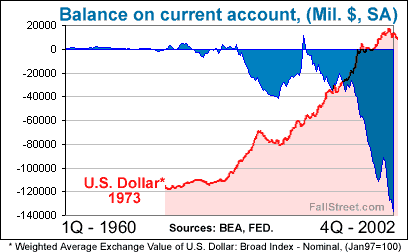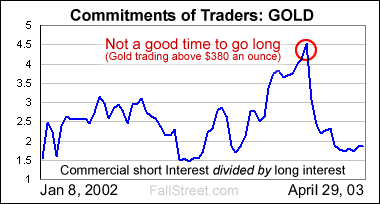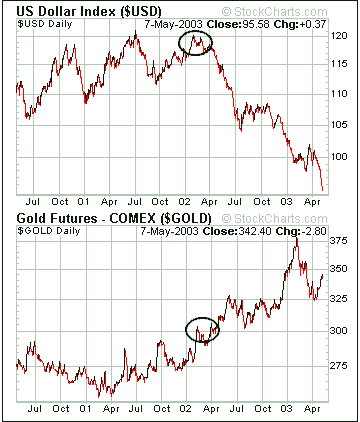May 10, 2003
Greenback Attack Puts Gold Rally Back on Track
Notwithstanding the current two day decline, key stock market resistance levels have been broken with authority, tech stocks are back in style, and many analysts are forecasting even larger gains. The bull is back, or at least the Acampora’s would have us believe (‘any hesitation is a buying opportunity’).
On an amusing note, Michael Holland from Holland & Co. notes, “We still have some remnants of the bear market skepticism.” Given the circumstances – that being an overvalued stock market becoming more overvalued despite lackluster economic news - the argument that we still have some remnants of the bull market optimism seems more applicable.
As for the global markets, the action has been much the same, with the exception of Japan and China (the Nikkei and Hang Seng are two of the only major indices still down on the year). The economic news in Europe has been awful yet the FTSE and DAX have recently joined their American counterparts above their 200 DMAs. Germany may be entering a recession, yet its leading equity exchange, by some technical accounts, may be entering a bull market?
200 DMA Charts
Dollar Battered
Following Tuesday’s Fed statement the dollar’s slide began to intensify. Thus, Treasury Secretary Snow was told to go on CNBC and chant ‘strong dollar’ – something we haven’t heard in a little while but have come to expect when the dollar is under pressure. As reuters reported, some “suspected that Snow's remarks were aimed at attracting offshore investors to the U.S. government's record $58 billion Treasury refunding this week”. Despite Snow’s words, the quarterly refunding in question did not go that well.
Surprisingly, the U.S. dollar, which has lost nearly 20% of its value in the last year (as measured by the dollar index), has continued to slide even as equities rally. For anyone who has watched the markets over the last decade this is rare and strange occurrence. The dollar decline suggests (and the dated Treasury statistics confirm) that foreign capital is no longer enamored with owning U.S. assets.
The Good/Bad Points of a Declining Dollar
The reason why a declining dollar can be ‘bad’ news for everyone else, something Roach succinctly points out on a regular basis, is because other countries rely heavily on the U.S. economy (via exports to the U.S.).
Volkswagen’s net income fell 68 percent in the first quarter because of the euro's appreciation against the dollar. By contrast, thanks to favorable currency translations McDonald’s, IBM, and other American companies were able to pad earnings and beat 1Q03 estimates. In short, an interesting trend is emerging: a weaker greenback is good news for U.S. companies and bad news for everyone else.
For another example of why a weaker dollar can be great news for U.S. companies consider Steinway Musical Instruments. Steinway is currently selling many of its musical instruments (not pianos) within the United States at cost since it can not compete with its Asian competitors. A weaker dollar would make Steinway more competitive domestically, and also internationally.
Incidentally, a company like Steinway, and many others like it, need a weaker dollar sooner rather than later. To be sure, unless the dollar significantly weakens, within a few months Steinway will be closing down some plants as it looks to source more production to Asia.
Despite all the potential negatives, a declining dollar can actually save U.S. jobs, and, quite obviously, combat deflationary pressures (cheap imports becoming more expensive). In sum, despite the queasy feeling policy makers get when the dollar declines, given the U.S.’s escalating/unsustainable current account deficit a slumping dollar is terrific news. Rather than look foolish when this seeming perfect outlook goes awry, I will add the caveat that a crashing dollar is terrifically bad news.
 |
The Gold Rally is for Real…
The price of gold has a funny way of being slammed lower for no apparent reason just when it looks like it will consolidate gains. However, this time, and this is my first time making such a claim, things could be different.
To begin with, the COT data suggests that much of the speculative excess that was present during the last rally has vanished. For example, when gold peaked earlier this year, the commercials were more than 4.5-1 short. Today (April 29) commercial interest is less than 2-1 short. Furthermore, speculative interest at the peak was nearly 4.5-1 long, whereas today the speculators are less than 3-1 long. Suffice it to say, a lot of weak hands were shaken out when the POG collapsed, and the commercials (as the story usually goes) used this opportunity to nearly double their long positions while reducing their short positions.
 |
Along with the moderately bullish COT numbers, the fact that the dollar is in a slump bodes well for the POG. And although it is mugs game to speculate on what the dollar will do in the near term, longer term, say 2-5 years, the dollar is likely to encounter some setbacks. This dollar forecast is nothing new. However, what could be ‘new’ as far as the POG is concerned, is that when the inevitable ‘oversold’ dollar rally arrives that it will be short lived. In sum, a crash in the POG is about as likely as a sustained rally in the U.S. dollar.
 |
But Gold Stocks Are No Steal
Since early 2002 Todd and I have researched the gold industry countless time. Yet we continue arrive at the same conclusion: stocks/industries which are unattractive have more attractive properties than gold stocks do. Some comments that didn’t make it into the 1Q03 WL report highlight this point of view:
“If Goldcorp can be expected to emulate its 2002 performance in 2003 (consensus estimates suggest as much) the investor is paying roughly 40 times free cash flow for a stock that has great potential if the POG rallies. However, if GG made say soup instead of mined gold and it had the same price/FCF ratio as Campbell Soup it would be trading at roughly $5.30 a share, not $10.61. Point being, Campbell Soup has a 3% dividend yield and we are fairly certain it will be around for the rest of lives, whereas Goldcorp offers less than a 1% dividend yield, and unless the company continues to find more reserves and/or the POG doesn’t decline, its days are numbered…”
Regardless of the rich valuations compared to other stocks, I’ll be the first person to admit that it is difficult not to purchase a company like Goldcorp, write some out of the money covered calls, and sit on the position. Indeed, there are many gold stocks which could potentially serve as income generating gold futures contract; the covered calls generate income and offer downside protection on your original investment while you participate in any gold rally up until your strike price. Moreover, if the calls expire worthless you continue to write calls and hope that the POG doesn’t collapse (this ‘strategy’ is based upon ‘hope’ if you don’t believe he company is undervalued).
Suffice it say, and despite being bullish on the POG, I lack the speculative flare to venture into gold stocks at current prices. Yet the thought continues to cross my mind.
Conclusions
Gold could be due for a near term setback (the COT stats are not always reliable and they are dated), but because the dollar’s decline is likely just beginning, the long-term outlook for gold is positive. I don’t believe that purchasing gold is something you jump up and cheer about. Rather, buying gold serves as an admission of defeat -- you can not find an attractive use for capital and you are apprehensive about holding paper, so you purchase some gold.
The stock picker cannot help but be discouraged by the current rally, as many stocks that were nearly attractive two months ago are now completely unattractive. Nevertheless, and as Wall Street begins to bombard the public with claims of a new bull market, the investor should remain resolute. Purchasing a stock because you believe someone will pay a higher price for your shares tomorrow – not neccessarily because you believe the stock is attractively priced and the stock will mirror corporate performance – is living dangerously. Gold on the other hand, is one of only safe choices.
All data and information within these pages is thought to be taken from reliable sources but there is no guarantee as such. All opinions expressed on this site are opinions and should not be regarded as investment advice.
Copyright © 2000-2003. FallStreet.com